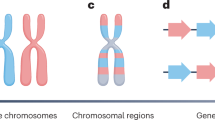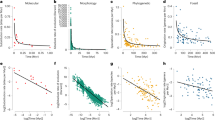Abstract
Arising from D. L. Theobald Nature 465, 219–222 (2010)10.1038/nature09014; Theobald reply
The question of whether or not all life on Earth shares a single common ancestor has been a central problem of evolutionary biology since Darwin1. Although the theory of universal common ancestry (UCA) has gathered a compelling list of circumstantial evidence, as given in ref. 2, there has been no attempt to test statistically the UCA hypothesis among the three domains of life (eubacteria, archaebacteria and eukaryotes) by using molecular sequences. Theobald2 recently challenged this problem with a formal statistical test, and concluded that the UCA hypothesis holds. Although his attempt is the first step towards establishing the UCA theory with a solid statistical basis, we think that the test of Theobald2 is not sufficient enough to reject the alternative hypothesis of the separate origins of life, despite the Akaike information criterion (AIC) of model selection3 giving a clear distinction between the competing hypotheses.
Similar content being viewed by others
Main
Dawkins4 argued that even though it may, at first, seem unlikely that such a complex structure as the eye evolved by selection, it could have been realized by a long sequence of small evolutionary steps driven by selection. Theobald2 mentions that statistically significant sequence similarity can arise from factors other than common ancestry, such as convergent evolution due to selection, but such factors were not taken into account in his ‘formal’ test to reject the independent origins hypothesis.
Table 1 shows that the formal test provides support for a common origin of two putatively unrelated genes, mitochondrial cytb and nd2, with no homology. However, we believe that this result should not be regarded as evidence of the ultimate common ancestry of cytb and nd2. This raises a question mark as to the effectiveness of the formal test applied by Theobald2. It should be noted that, because alignment gives a bias for common ancestry, we did not make an alignment between cytb and nd2. To reject the separate origins hypothesis of the domains of life, it would be indispensable to develop a more ‘biological’ test to show that even by improving the model of the separate origins by taking into account biological factors such as the possibility of convergent evolution due to selection, the UCA hypothesis is still supported by the AIC. To do this, it is necessary to develop an entirely new methodological framework of molecular phylogenetics that is different from the conventional framework that neglects convergent and parallel evolution. Notably, there have been many reported cases of convergent and parallel evolution misleading molecular phylogenetic inference5,6,7,8,9, and such a method is needed for molecular phylogenetics in general.
References
Darwin, C. On the Origin of Species by Means of Natural Selection, or, The Preservation of Favoured Races in the Struggle for Life (J. Murray, 1859)
Theobald, D. L. A formal test of the theory of universal common ancestry. Nature 465, 219–222 (2010)
Akaike, H. in Second International Symposium on Information Theory (eds Petrov, B. N. & Csaki, F.) 267–281 (Akademiai Kiado, 1973)
Dawkins, R. The Blind Watchmaker: Why the Evidence of Evolution Reveals a Universe without Design (Longman Scientific & Technical, 1986)
Stewart, C.-B., Schilling, J. W. & Wilson, A. C. Adaptive evolution in the stomach lysozymes of foregut fermenters. Nature 330, 401–404 (1987)
Christin, P. A., Salamin, N., Savolainen, V., Duvall, M. R. & Besnard, G. C4 photosynthesis evolved in grasses via parallel adaptive genetic changes. Curr. Biol. 17, 1241–1247 (2007)
Liu, Y. et al. Convergent sequence evolution between echolocating bats and dolphins. Curr. Biol. 20, R53–R54 (2010)
Li, Y., Liu, Z., Shi, P. & Zhang, J. The hearing gene Prestin unites echolocating bats and whales. Curr. Biol. 20, R55–R56 (2010)
Zhong, B., Yonezawa, T., Zhong, Y. & Hasegawa, M. The position of Gnetales among seed plants: overcoming pitfalls of chloroplast phylogenomics. Mol. Biol. Evol. 10.1093/molbev/msq170 (2 July 2010)
Yang, Z. PAML 4: Phylogenetic Analysis by Maximum Likelihood. Mol. Biol. Evol. 24, 1586–1591 (2007)
Author information
Authors and Affiliations
Contributions
T.Y. and M.H. designed the work, T.Y. carried out the analysis, and M.H. wrote the manuscript.
Ethics declarations
Competing interests
Competing financial interests: declared none.
Rights and permissions
About this article
Cite this article
Yonezawa, T., Hasegawa, M. Was the universal common ancestry proved?. Nature 468, E9 (2010). https://doi.org/10.1038/nature09482
Received:
Accepted:
Published:
Issue Date:
DOI: https://doi.org/10.1038/nature09482
This article is cited by
-
Infinitely long branches and an informal test of common ancestry
Biology Direct (2016)
-
Molecular phylogeny of the higher and lower taxonomy of the Fusarium genus and differences in the evolutionary histories of multiple genes
BMC Evolutionary Biology (2011)
-
Theobald reply
Nature (2010)
Comments
By submitting a comment you agree to abide by our Terms and Community Guidelines. If you find something abusive or that does not comply with our terms or guidelines please flag it as inappropriate.



